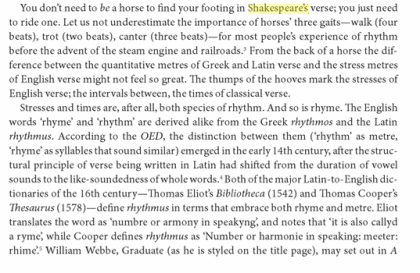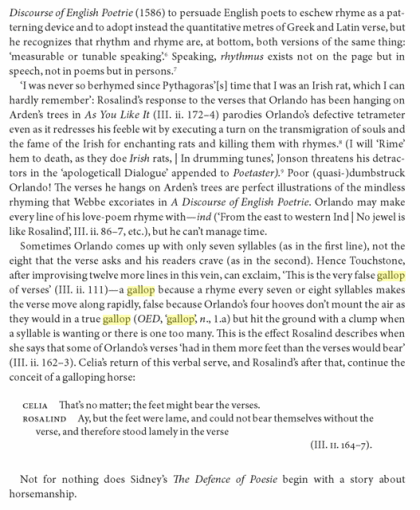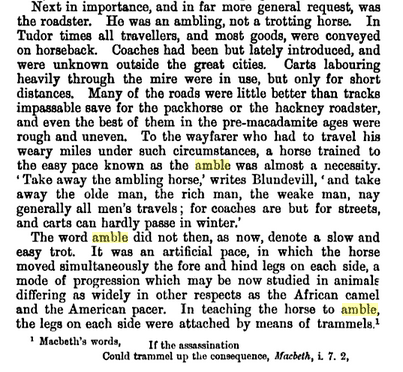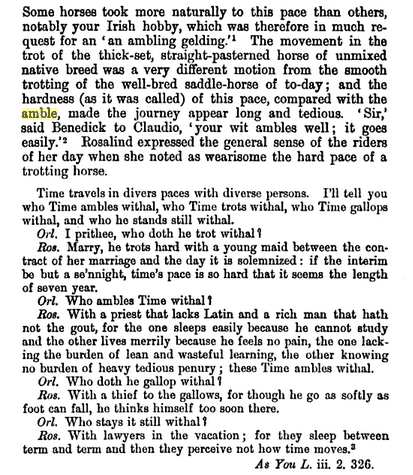Posts from — May 2014
Hamlet’s Feet
Rambler’s blog returns again and again to the M-B-L (sometimes M-P-L) marker which over time, one realizes is attached to so many allusions of Vere in works of his contemporaries. Vere is often described as ambling, nimble, ample etc. Ben Jonson also used it naming characters in his plays, who invariably stand, at least it part, for Vere. Rambler recently recounted “Ambler in The Devil is an Ass; Master Ambler in Staple of News; Frampul in The New Inn; and Preamble-Bramble in A Tale of a Tub.” and there’s a Bramble in Every Man in His Humour as well.
Rambler speculates that the B in the M-B-L construction is a pronounciation tic from Hamblet. Perhaps, but I’m not completely satisfied, which brought me to taking a look at this topic. I think the M-B-L usage is a double-entendre. In part, it is alliterative of Hamlet. The other part is an explication of Shakespeare’s contribution to verse.
First, some background reading. This link brings up three Rambler posts that are central to the discussion. Once you’re briefed on those, we’ll proceed.
I want to focus in on this snippet of Lorenzo Jr’s comment that Rambler discussed in the link.
“…and have translated begging out of the old hackney pace to a fine, easy amble, and made it run as smooth off the tongue as a shove-groat shilling…”
Additional Rambler commentary from that link is important.
“— Run smooth off the tongue: In The Devil is an Ass, Ambler regales Merecraft with his tale of woe, and Jonson’s own stage direction states: ‘
Ambler tells this with extraordinary speed’. Evidently Vere was able to speak mellifluously, since Ambler doesn’t stumble over his words;
Vere spoke fast and smoothly. Rambler’s established that. But hackney pace refers to more than just his Hackney place where Vere lived at the time. A hackney is a horse-drawn carriage. If you’ve ever taken a ride in a carriage through Central Park in NYC or elsewhere you’ve been in a hackney. The pace of these carriages is a slow walk, Clop, Clop, Clop, Clop.
The first OED definition of the verb, amble, is “Of a horse, mule, etc.: To move by lifting the two feet on one side together, alternately with the two feet on the other; hence, to move at a smooth or easy pace.”
An amble is a specific horse gait. It’s speed is faster than a walk, and slower than a canter. It is also smooth and elegant to watch. Not all horses can do it.
“And have translated begging out of the old hackney pace to a fine, easy amble,”
My gloss: Shakespeare has transformed (translated) the pace of acting (begging) from a slow walk (hackney pace) to a faster gait (a fine, easy, amble.)
From the Oxford Handbook of Shakespeare’s Poetry – p. 324
“You don’t need to be a horse to find your footing in Shakespeare’s verse; you just need to ride one. Let us not underestimate the importance of horses’ three gaits – Walk (four beats), trot (two beats), canter (three beats)…”
The writer above commits an error in omitting the amble (and the gallop) from the list of horse gaits. It’s the amble, and not the walk, trot, canter, or gallop that marks Shakespeare’s verse. Let’s delve further into the connection between horse gaits and poetic meter. Here’s a larger excerpt from the Oxford Handbook of Shakespeare’s Poetry. pps 324-325
click to enlarge
click to enlarge
The ‘false gallop’ that Touchstone calls Orlando’s verse is a specific gait. That was the term for what is now called the canter. A canter is similar to a gallop, but is a shorter stride. Thos Nashe in Strange News used the term as well,
“I would trot a false gallop through the rest of his ragged Verses, but that if I should retort his rime dogrell aright, I must make my verses (as he doth his) run hobling…”
The long verses in the Arthur Golding’s translation of Ovid’s metamorphoses are called “galloping fourteeners” though the term ‘fourteener’ was not in use in Tudor times. Other long metrical lines such as Alexandrines are said to gallop as well.
The amble is a different gait. It is also called the pace, or the rack at varying speeds. The legs on each side of the horse move together. Here’s another example of a horse with a paced gait. This one is moving quite fast.
click to enlarge
Let’s discuss what makes the amble different from other horse gaits. It is smooth. Notice the rider above. He’s not being jostled up and down in the saddle, as a rider of a cantering, trotting or galloping horse would be. The smoothness of the ride made ambling the preferred method of travel at a time when coaches were not in use outside of the cities. The ambling horse allowed for an easy ride, less tiring on the rider than other gaits. Poetically, the thump, thump, thump of galloping meter has the rhyming as the source of that jostling thump. The rider is bounced in the saddle from the rhyme.
“…we have largely forgotten how much trotting and galloping of nursery rhymes and other thumping of heavily accented verses echoed in our minds before we arrived at the meter of our own first ballads and sonnets.”
Margaret Holley Words Moving: Metrical Pleasures of our Time
When Shakespeare uses the terms amble and easy, he’s describing meter that doesn’t bounce you in the saddle. He’s describing blank verse. Here’s Benedick in Much Ado.
“I mean in singing; but in loving, Leander the good
swimmer, Troilus the first employer of panders, and
a whole bookful of these quondam carpet-mangers,
whose names yet run smoothly in the even road of a
blank verse, why, they were never so truly turned
over and over as my poor self in love.” (V, ii)
And Claudio & Bendick
Claudio.
I’ faith, I thank him; he hath bid me to a calf’s
head and a capon; the which if I do not carve most
curiously, say my knife’s naught. Shall I not find
a woodcock too?Benedick
Sir, your wit ambles well; it goes easily. (V,i)
Benedick is complimenting Claudio’s blank verse. Contrast that with Touchstone’s criticism of Orlando’s rhyming as a “false gallop” from As You Like It.
Touchstone.
For a taste:
If a hart do lack a hind,
Let him seek out Rosalind.
If the cat will after kind,
So be sure will Rosalind.
Winter garments must be lined,
So must slender Rosalind.
They that reap must sheaf and bind;
Then to cart with Rosalind.
Sweetest nut hath sourest rind,
Such a nut is Rosalind.
He that sweetest rose will find
Must find love’s prick and Rosalind.
This is the very false gallop of verses: why do you
infect yourself with them? (III,ii)Rosalind.
Peace, you dull fool! I found them on a tree.Touchstone.
Truly, the tree yields bad fruit.
The amble is to blank verse as the gallop, false gallop (canter), and trot are to rhyming verse.
_________________________________________________
Begin speculation….
Back to the description of Musco from Jonson’s Every Man in His Humor.
“…and have translated begging out of the old hackney pace to a fine, easy amble, and made it run as smooth off the tongue as a shove-groat shilling…”
Jonson is telling us that Shakespeare transformed the meter of English theater in his day. Before Shakespeare/Musco, begging (acting) was at a “hackney pace.” Shakespeare brought the easy, ambling, blank verse to the theater. I think Jonson here is crediting Shakespeare (not Marlow!) with the introduction of blank verse on the stage.
A few lines later in EMI – Musco is praised.
“…unless a Man had juggled Begging all his Life-time, and been a Weaver of phrases from his infancy for the apparelling of it, I think the world cannot produce his Rival.
Rambler remarked that is the quintessential description of who Shakespeare was (paraphrasing.) I think the earlier quote is the quintessential description of what Shakespeare did, at least in terms of language in the theater.
Jonson’s continued naming of Vere characters with the A-M-B-L-E (with variation) construct is a homage to Vere’s contribution to the language of the theater, blank verse. It’a also an alliterative tip of the hat to Hamlet.
Hamlet’s nimble, ample, iambs amble.
_______________________________________
Additional details.
Horses do not naturally move with an ambling gait. They must be trained. Some breeds are more amenable to learning the gait than others. In Tudor times, a specific breed, now extinct was the preferred ambling horse. That breed was the Irish Hobby. (an A-Ha! moment for Rambler readers.) The hobby horse takes its name from the Irish Hobby.
The sections below are from The Diary of Master William Silence (1907.)
click to enlarge
click to enlarge
May 16, 2014 No Comments





